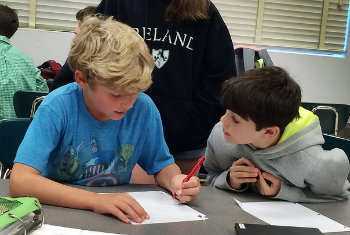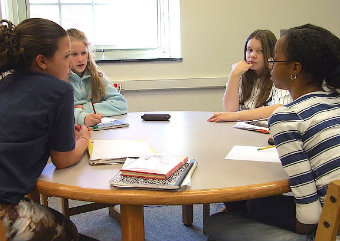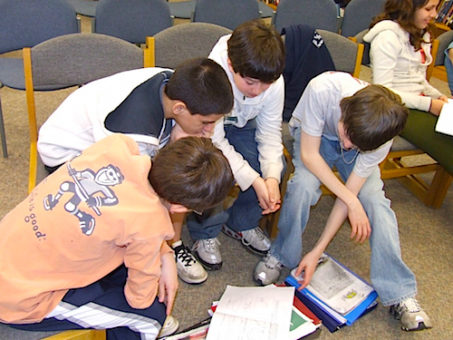Kids Teaching Kids Leads to Healthy Lessons
 By Allison Fink
By Allison Fink
As one trimester was coming to a close and a new one about to begin, it dawned on me that one way to engage my students with the material in health class was to have them teach a lesson the way they would like to be taught.
Generally speaking, I have amazing, high achieving students, but they need to step out of their comfort zone to improve both their academic skills and their oral presentation skills. One way to do that, I decided, was to engage them in “cross teaching” each other.
As it turned out, my students were very active in developing a learning plan and establishing their own focus, and I was pleased with the results. Here’s an overview of our first “students teaching students” experience, including the basic organizational structure, students creating a lesson plan, students teaching the lesson, student self-reflection, and my own teacher reflection.
Form Groups and Select Topics

Within this specific unit, we learned about topics such as overall health, self-esteem, empathy, overcoming hardships, stress, and depression. In order to create a certain level of fairness, student groups had to draw one of the above-listed topics out of a hat and teach the content.
Once they received the primary topic, they had to narrow their lesson focus. As students created their lesson, they were required to use basic vocabulary terms and apply the material to their own lives while intertwining it with the class content.
This activity engaged all my students and allowed them to take an active part in their own learning.
Provide Class Time for Lesson Planning
Throughout the planning process, I sat with each group to review their topic and aid them with the specific information they wanted to teach. One of the most rewarding aspects of this project was meeting with each group individually to discuss their vision.

► Second, we picked roles for each group member, such as facilitator, task manager, timekeeper, and data checker.
► Third, each group member needed to participate in planning the group’s presentation, ensuring participation.
► Overall, each group had to relate the topic to their own life and apply it to situations they might experience.
I also included students in the design of the grading rubric. Students who are involved in the process of creating a rubric have a better understanding of the standards and expectations of the assignment. They also understand what they need to learn and teach.
Throughout the process, we edited the rubric to create more clear expectations for the assignment. While reflecting, one student said: “I got the chance to help change the rubric, so I feel that I helped make the project better.” This student in particular analyzed the verbiage, which really helped us fine-tune the gradation within the rubric.
Finally, students were given a specific time slot over several different class periods to do their teaching. On the day each group presented their lesson, students had to turn in all of the pertinent information they used and created to support their presentation.
Students Teaching the Lesson

Any in-class questions on the material should be addressed to the group teaching the lesson. When all students are given authentic learning opportunities to both learn and demonstrate their knowledge, the process is powerful and great things can happen.
As part of the summarization and reflection process, we discussed the positive aspects of each group’s lesson and the different things they could work on for next time. As the first few groups completed their presentations, it provoked others to enhance their own lessons — for example, by observing that “we really need to work on our exit slips.”
Overall, each group was prepared, organized and stayed within their learning objective.
Completing the Student Self-Reflection
One of the final processes of the project was self-assessment and reflection. This portion of the project helps students identify personal strengths and weaknesses for future learning. Students also assess one another in the group and grade each other based on their contribution to the process. It is empowering for students to reflect on themselves and their work in order to improve for their next teaching adventure.
Teacher Reflection
This process was well worth the additional time and effort in the classroom, and I plan on employing it in my classes in the future. Students-teaching-students easily applies to all types of learners.
I would recommend a few things to keep in mind as other teachers experiment with this process.
One: Help students understand the difference between presenting and learning how to teach a lesson.
Two: Provide enough time for students to completely educate themselves on the topic they’ve been randomly assigned.
Three: Provide adequate resources for the students as they are putting their lessons together.
Four: I would recommend that as students are listening to the lessons they make notes so they can thoughtfully reflect and ask questions.
Last: Try to ensure that your students are challenged by their lesson and can really learn from their own information.
Putting It All Together
Overall, students were very active in the development of their education, establishing self-directed learning and making the learning process more interesting and inspirational. The overarching process of students-teaching-students was very rewarding and provided a cooperative learning opportunity that helped grow team-working skills.
Feature image: Kevin Jarrett
___________
Allison Fink is a middle school health teacher in Lake Bluff, Illinois. This is Allison’s 9th year teaching. She believes her role is to ensure that her students are able to draw on various experiences and create healthful outcomes based on their behavior and decision making. She also believes it’s her responsibility to help students feel comfortable and provide a safe learning environment for them to share their thoughts and concerns. In addition to teaching, Allison coaches high school girls’ volleyball and 7th grade boys’ basketball and volleyball.



































Congratulations again! Not sure how you got to be so smart in the teaching field, but you certainly have an excellent approach to an often challenging period for younger students. Think you might have a few genes (teaching) from the many other ‘Fink family’ members who have taught through the years, going all the way back to your great grandma Fink who taught in country schools? We are very proud of you!!
Thank you Dad! I got my perseverance from you, always onward and upward!!
Thank you for a clearly constructed article; I appreciate the clear explanations of your methods and processes. I was actually thinking about this concept/idea this morning; random Saturday morning thoughts. It was a nice surprise to see your article on my Facebook feed! Serendipitous! Have you ever tried a Student EdCamp model? Less formal but still the same idea of students teaching students. I am just exploring it myself after attending a teacher EdCamp (@EdCampHCPS). Thanks again for great thoughts; shared on Twitter (@YodaPond). Have a wonderful day!